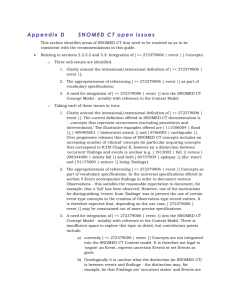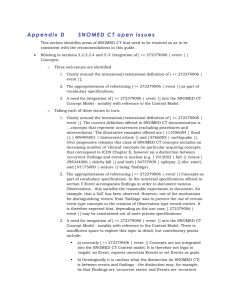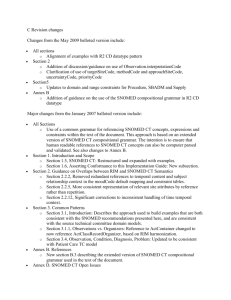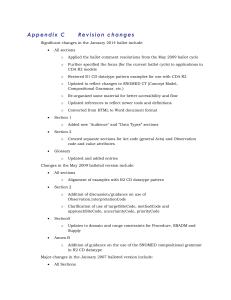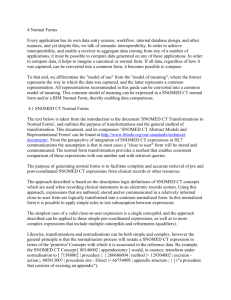5 SNOMED CT vocabulary concept domain constraints 5.1
advertisement
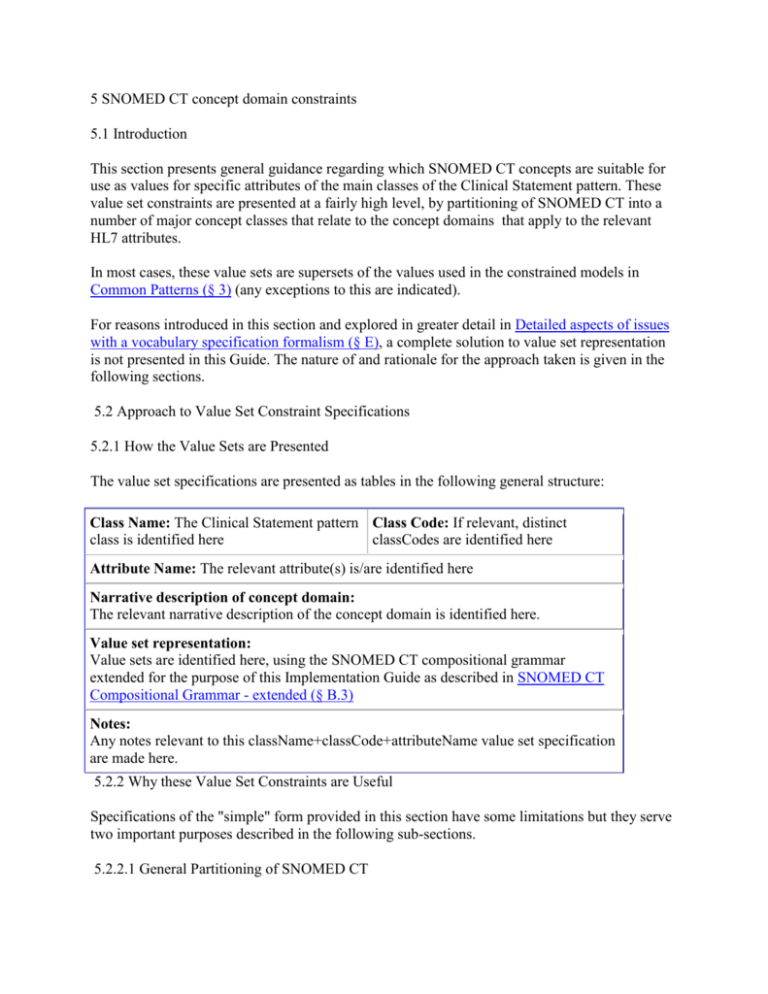
5 SNOMED CT concept domain constraints 5.1 Introduction This section presents general guidance regarding which SNOMED CT concepts are suitable for use as values for specific attributes of the main classes of the Clinical Statement pattern. These value set constraints are presented at a fairly high level, by partitioning of SNOMED CT into a number of major concept classes that relate to the concept domains that apply to the relevant HL7 attributes. In most cases, these value sets are supersets of the values used in the constrained models in Common Patterns (§ 3) (any exceptions to this are indicated). For reasons introduced in this section and explored in greater detail in Detailed aspects of issues with a vocabulary specification formalism (§ E), a complete solution to value set representation is not presented in this Guide. The nature of and rationale for the approach taken is given in the following sections. 5.2 Approach to Value Set Constraint Specifications 5.2.1 How the Value Sets are Presented The value set specifications are presented as tables in the following general structure: Class Name: The Clinical Statement pattern Class Code: If relevant, distinct class is identified here classCodes are identified here Attribute Name: The relevant attribute(s) is/are identified here Narrative description of concept domain: The relevant narrative description of the concept domain is identified here. Value set representation: Value sets are identified here, using the SNOMED CT compositional grammar extended for the purpose of this Implementation Guide as described in SNOMED CT Compositional Grammar - extended (§ B.3) Notes: Any notes relevant to this className+classCode+attributeName value set specification are made here. 5.2.2 Why these Value Set Constraints are Useful Specifications of the "simple" form provided in this section have some limitations but they serve two important purposes described in the following sub-sections. 5.2.2.1 General Partitioning of SNOMED CT A large clinical terminology, such as SNOMED CT, represents a number of lexically similar concepts which are grammatically, linguistically or semantically distinct. This phenomenon is particularly pronounced if the terminology is considered without any kind of partitioning. The coarse-grained partitioning specified by these constraints simplifies and clarifies decisions about which of a set of superficially similar SNOMED CT concepts are appropriate to particular HL7 concept domains. For example, consider a concept domain specification that is intended to represent "an adverse event in reaction to a drug". The most suitable SNOMED CT concepts to represent such an event would be those subsumed by [ <<62014003 | adverse reaction to drug ]. However from a lexical perspective other less appropriate concepts may appear to be suitable. For example o The reference to "adverse drugs reaction" may suggest use of subtypes of the procedure concept [ <<396079007 | assessment of adverse drug reactions ]. o The reference to "drug" may suggest concepts in the use of subtypes of [ <<373873005 | pharmaceutical / biologic product ] or [ <<410942007 | drug or medicament ]. The simple value set constraints in these specifications exclude these inappropriate alternatives and thus provide a helpful guide for value set developers. 5.2.2.2 Starting Point for SNOMED CT Model-based Value Set Specifications The Schematic Illustrations of SNOMED CT Expressions (§ E.6) identify the "clinical kernel" or primary clinical "focus concept" that may exist alone or as part of a contextualized expression. In most cases, the simple value set constraints in this specification apply to this clinical focus concept. In combination with the SNOMED CT concept model these constraints form a foundation for more detailed "complete" value set specification (as explored in Detailed aspects of issues with a vocabulary specification formalism (§ E)). Simple value set constraints can be regarded as a set of subsumption clauses related by OR logic. Each clause permits the inclusion of a focus concept that is subsumed by a specified concept. In contrast, a more complete specification would check normal form transformations of candidate expressions against a variety of subsumption and role-based restrictions. In addition a complete specification requires support of a full set of logical operators between clauses (i.e. OR, AND, NOT). For example, consider a value-set constraint which indicates that the "focus concept" must be a kind of [ <<404684003 | clinical finding ]. The concept model indicates that a [ 404684003 | clinical finding ] concept o can be refined by name/value pairs with attribute names such as [ 363698007 | finding site ], [ 246112005 | severity ], [ 116676008 | associated morphology ] etc., o can be the value to the attribute name [ 246090004 | associated finding ] as part of the definition or refinement of a [ 413350009 | finding with explicit context ] as part of post-coordinated expression that includes the [ 404684003 | clinical finding ] within a context wrapper. A comprehensive notation for value sets that allow subtypes of [ 404684003 | clinical finding ] may therefore also need to indicate whether any limitations apply either to the refinement or situation in which the concepts are used. o The context wrapper may, for instance, be used to communicate negation and uncertainty and may thus be required to support some types of information. However, it may also be necessary to constrain the use of context in a manner that is relevant to the Act.moodCode or other attributes and association in the HL7 representation. 5.2.3 Why the Value Set Constraints are Incomplete A simple approach to value set constraints is inevitably incomplete when applied to SNOMED CT as a result of two features supported by SNOMED CT. 1. The ability to create, and the requirement to communicate, post-coordinated SNOMED CT expressions. 2. The ability to use pre-coordinated expressions referring to concept that are subtypes of [ 243796009 | situation with explicit context ]13. Both these SNOMED CT features are useful for the detailed coded capture of clinical data. However, they create a challenge for value set representation that cannot be fully met by the simple approach used in this specification. As outlined in the following sections, the inadequacy of the simple approach introduces the risks of false-positive and false-negative results. 5.2.3.1 False Negatives - Rejection of Valid Expressions Two different aspects of SNOMED CT post-coordination ("attribute refinement" and "context/situation wrapping") may result in the valid expressions being rejected by "simple" value sets tests. Example of "attribute refinement" false negative: The concept [ 82764005 | operation on duodenum ] could be refined by applying more specific values to its [ 260686004 | method ] and [ 363704007 | procedure site ] attributes. If the value for [ 260686004 | method ] is refined to [ 129304002 | excision - action ] and the value for [ 363704007 | procedure site ] to [ 181247007 | entire duodenum ], the resulting expression means "excision of the entire duodenum" and we would expect this to mean the same as "total excision of duodenum". This expression would be inappropriately rejected by a "simple" value set test of the instruction [ <<173848007 | total excision of duodenum ] (i.e. "include 'total excision of duodenum' any sub-types"). This false negative arises because [ 82764005 | operation on duodenum ] is not a subtype of [ 173848007 | total excision of duodenum ]. In order to obtain the appropriate result, a more complex test must be performed. This involves comparison of the normal forms of the two expressions. Example of "context/situation wrapping" false negative: The concept [ 373573001 | clinical finding present ] can be refined by applying a more specific value to its attribute [ 246090004 | associated finding ]. If the value for [ 246090004 | associated finding ] is refined to [ 404640003 | dizziness ], the resulting post-coordinated expression means "dizziness present". This expression would be inappropriately rejected by a "simple" value set test of the instruction [ <<404640003 | dizziness ] (i.e. "include 'dizziness' and any sub-types"). This false negative outcome is because [ 373573001 | clinical finding present ] is not a subtype of [ 404640003 | dizziness ]. In order to obtain the appropriate result, a more complex test must be performed. This involves comparison of the normal forms of the two expressions, taking into account the default context of a SNOMED CT 'finding'. 5.2.3.2 False Positives - Acceptance of Invalid Expressions A potential pattern of false positive value set testing would result from attempts to augment the "simple" value set specifications to include corresponding "context/situation" Concepts. The absence (by design) of an exhaustive set of "context/situation" Concepts corresponding to each "finding" or "procedure" Concept means that on many occasions only the specification of a more general "situation" Concept will guarantee that desirable Concepts will be included, but at the expense of allowing multiple false positives. Example of pre-coordinated "situation" false positive: Consider a value set designed to include "respiratory disorders". To avoid rejecting concepts which include explicit context, a simple value set might include [ <<413350009 | finding with explicit context ] as well as [ <<50043002 | disorder of respiratory system ]. Such a clause would include the relevant respiratory findings, including those with explicit context. However, it would also inappropriately include other findings with explicit context (i.e. non-respiratory finding with explicit context). Failure to include [ <<413350009 | finding with explicit context ] would result in false negatives as illustrated in the previous section. In order to obtain the appropriate result, a more complex test must be performed. This involves restricting the inclusion of subtypes of [ 413350009 | finding with explicit context ] to those with a value for [ 246090004 | associated finding ] that are in the set specified by [ <<50043002 | disorder of respiratory system ]. 5.3 Constraint Specifications The "simple" value set constraints are provided as a set of tables, covering the major classes of the Act and Entity Choice boxes. 5.3.1 Specifications 5.3.1.1 Observation Class Name: Observation Class Code: OBS Attribute Name: Observation.value Narrative description of concept domain: An act that is intended to result in new information about a subject. The main difference between observations and other acts is that it has a value attribute that is used to state the result of the assessment action described in Act.code. Simple representation: ((<<404684003 | clinical finding |) OR (<<413350009 | finding with explicit context |) OR (<<272379006 | event |)) Notes: Where Observation.code = ASSERTION. An alternative approach (now deprecated) is for the same value set to be communicated in Observation.code where the attribute Observation.value is not present in the Observation class instance. As indicated in section 2.2.2.2 subheading 7, the situation may arise in which Observation.value is a SNOMED CT expression from the set specified in the 'simple representation' field of this table and Act.code is represented by a code other than "ASSERTION". Such an approach can only be safely used if interpretation of the Act.code together with the Observation.value does not yield a meaning that is substantially different from the meaning implied if the Act.code was "ASSERTION". Without exhaustive scrutiny of SNOMED CT's content it is not possible to identify that set of codes can safely be used in this way in Act.code. A further alternative representation is needed to communicate record entries where SNOMED CT content has been used to represent Observation.code and Observation.value is present. Observation.value may be a numeric, nominal or ordinal result, so itself may come from SNOMED CT also: Class Name: Observation Class Code: OBS Attribute Name: Observation.code Attribute Name: Observation.value Narrative description of concept domain: An act that is intended to result in new information about a subject. The main difference between observations and other acts is that it has a value attribute that is used to state the result of the assessment action described in Act.code. Simple representation for Observation.code: ((<<386053000 | evaluation procedure |) OR (<<363787002 | observable entity |)) Simple representation for Observation.value (where SNOMED CT-encoded): ((<<281296001 | result comments |) OR (<<260245000 | findings values |)) Notes: As noted in Section 3, editorial debate continues regarding whether or not [ <<363787002 | observable entity ] concepts should be recommended for use in Observation.code; It should also be noted that the Observation.value specification is limited to those values specified by the SNOMED CT concept model as suitable targets for the [ 363713009 | has interpretation ] attribute. This specification would currently disallow/exclude the value [ 371246006 | green color ] used in Example 1 of Section 3. 5.3.1.2 Procedure Class Name: Procedure Class Code: PROC Attribute Name: Procedure.code Narrative description of concept domain: An Act whose immediate and primary outcome (post-condition) is the alteration of the physical condition of the subject. Simple representation: ((<<71388002 | procedure |) OR (<<129125009 | procedure with explicit context|)) AND (!432102000 | Administration of substance|) AND (!<243704004 | provision of appliances|) AND (!<183253002 | provision of medical equipment |) AND (!<404919001 | wheat-free diet) AND (!<223456000 | provision of a special diet) AND (!<440298008 | Dispensing of pharmaceutical/biologic product |)) Notes: in order to prevent overlap, this specification includes the negated clauses to exclude the value set of "Substance administration" and "Supply". 5.3.1.3 Substance Administration Class Name: SubstanceAdministration Attribute Name: SubstanceAdministration.code Narrative description of concept domain: Introducing or otherwise applying a substance to the subject Class Code: SBADM Simple representation: (416118004 | administration |) optionally: <<432102000 | administration of therapeutic substance | Notes: In Release 1 of this guide, and in order to support a tighter standardization of this class and ensure that the "substance" administered was only represented in the related Material Entity, SNOMED CT content that explicitly referred to substances (for example 39543009|administration of insulin (procedure)|) were excluded (by a specification that limits the codes offered and disallows any of the subtypes. ) In response to examples that have been identified where specific subtypes of 432102000 | Administration of substance (procedure) | are required for use in SubstanceAdministration.code, the looser optional constraint is offered to provide access. Nevertheless, the intent of the guide (to ensure that the "substance" administered was only represented in a related Material Entity) still holds to enable consistent analysis. 5.3.1.4 Supply Class Name: Supply Class Code: SPLY Attribute Name: Supply.code Narrative description of concept domain: The provision of a material by one entity to another Simple representation: ((<<243704004 | provision of appliances|) OR (<<183253002 | provision of medical equipment |) OR (<<404919001 | wheat-free diet|) OR (<<223456000 | provision of a special diet|) OR (<<440298008 | Dispensing of pharmaceutical/biologic product |)) Notes:Possibly incomplete. Currently SNOMED CT has no abstract notion of the "supply/provision of material", so whilst diet and appliances, equipment and pharmaceutical/biologics are supported, it is still possible that some cases are not supported. 5.3.1.5 Organizer Class Name: Organizer Class Code: ORGANIZER Attribute Name: Organizer.code Narrative description of concept domain: Organizer of entries. Navigational. No semantic content. Knowledge of the section code is not required to interpret contained observations. Represents a heading in a heading structure, or "organizer tree". Simple representation: ((<<419891008 | record artifact |) OR (<<386053000 | evaluation procedure |)) Notes: [ <<386053000 | evaluation procedure ] is included to allow the naming of batteries with Laboratory procedure terms. 5.3.1.6 Entity The following very general SNOMED CT value set for using the Entity.code attribute is outlined below. In any specific model this set should be appropriately constrained. Class Name: Entity Class Code: ENT Attribute Name: Entity.code Narrative description of concept domain: A physical thing, group of physical things or an organization capable of participating in Acts, while in a role. Simple representation: ((<<410607006 | organism |) OR (<<373873005 | pharmaceutical / biologic product |) OR (<<260787004 | physical object |) OR (<<105590001 | substance |) OR (<<123038009 | specimen |) OR (<<308916002 | environment or geographical location |)). Notes: (1) A more sophisticated division of SNOMED CT Entities is needed to reconcile with the coarse-grained specializations of Entity within the HL7v3 Specification (e.g. LivingSubject, Place, Manufactured Material...). (2) the SNOMED CT class [ 123038009 | specimen ] could be viewed as merging both the Entity and the specimen "role", however it is included in this specification, on the understanding that the "specimen" role would be restated within the Clinical Statement pattern-conformant specification. 5.3.2 Notes 5.3.2.1 moodCode influences A comprehensive notation for all SNOMED CT ‘findings and procedures" value sets is logically ‘wrapped" in the SNOMED CT context/situation wrapper, and indeed the context/situation wrapper would be used to communicate negation and uncertainty in message designs where SNOMED CT is the only permitted code system. In more "complete" value set constraint specifications therefore, it can be expected that the moodCode values found in message instances should influence the corresponding valid "finding and procedure context" values. Details of the recommended mappings are provided in Act.moodCode (§ 2.2.3) 5.3.2.2 Translations A value set constraint can be applied to any coded content where the codeSystem is SNOMED CT. This includes cases where original encoding is SNOMED CT or where the SNOMED CT encoding is based on a translation from another codeSystem. Thus the value set constraints may be tested against the original encoding or translation sub-element in an instance of the HL7 Concept Description (CD) data type. 5.3.2.3 Inactive SNOMED CT concepts New record entries should be made using SNOMED CT concepts with an active status. However it is possible that communications may contain SNOMED CT content that, while active at the time of entry, have subsequently been rendered inactive in the reference data (e.g. as a result of recognition or errors such as duplication or ambiguity). In these cases value set testing SHOULD include analysis of information contained in the SNOMED CT history data. Such data will assist in establishing the relationship(s) between inactive concepts and active concepts. If it can be demonstrated that an inactive concept has an appropriate historical relationship to a value set valid active concept, and if the specification does not explicitly exclude inactive concepts, then the inactive concept should be regarded as valid for communication. For example, consider the concept [ 274638001 | asthenia ], which is now marked as an inactive duplicate in SNOMED CT. This concept may have been active in the past, and may thus have been used in the creation a record entry. This historical record entry may subsequently be communicated (perhaps as part of a record extract), by which time the concept has been marked as inactive. If this is encountered it is possible (by analysis of the SNOMED CT history data) to identify the [ 168666000 | SAME AS ] relationship to the active concept [ 13791008 | asthenia ]. Assuming the message specification does not explicitly exclude inactive concepts it is then possible to test the (active) concept for suitability in the message instance and accept it as valid.
